GIS based benthic study @Pulicat
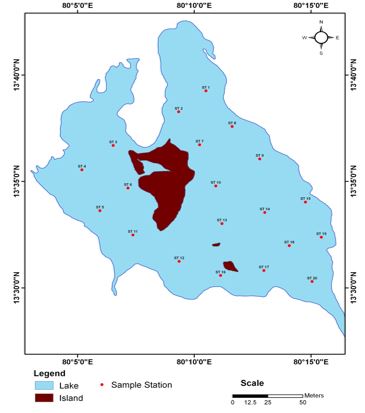 In the present study, a total of 156 species were recorded for both the years. Of this 46 species of Polychaetes, 16 species of Oligochaetes, 8 species of Tanaids, 18 species of Amphipods, 14 species of Isopods, 15 species of Nematodes, 9 species of Turbellarians, 3 species of Gastropods, 5 species of copepods, 2 species of Lorcifera, 3 species of Kinorhyncha, 4 species of ostracoda, 2 species of Tardigrade , 6 species of cumacea, 4 species of Bivalves and one species of Scalopod were recorded. Cerethidium cingulata, Bullia tranqubarica, Meretrix meretrix,
In the present study, a total of 156 species were recorded for both the years. Of this 46 species of Polychaetes, 16 species of Oligochaetes, 8 species of Tanaids, 18 species of Amphipods, 14 species of Isopods, 15 species of Nematodes, 9 species of Turbellarians, 3 species of Gastropods, 5 species of copepods, 2 species of Lorcifera, 3 species of Kinorhyncha, 4 species of ostracoda, 2 species of Tardigrade , 6 species of cumacea, 4 species of Bivalves and one species of Scalopod were recorded. Cerethidium cingulata, Bullia tranqubarica, Meretrix meretrix, 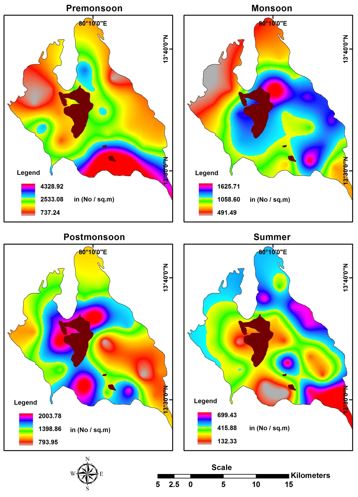 Villorita cyprinoides, Heteromastus filiformis, Mediomastus capensis, Cirratulus filiformis, Apseudes spinosus and Apseudes gymnophobia were occurred in most of the stations of the Pulicat Lake in irrespective of seasons. Polychaetes and tanadiceans were dominant in terms of diversity and density (Fig. 68). All other species were less dominant. In meiofauna, nematodes were dominant than other groups in the study. Temporal variation also found in the benthic faunal groups which explained that 2010-2011 year had increased faunal density and diversity compared to the year 2009-2010. The reason might be owing to high precipitation which caused nutrient supplement to the lake. But Tanaids alone had reduction in the population in the year 2010-2011 than the previous year. It might be due to in situ production of nutrients which are lacked in 2010 -2011. The supplement of nutrient is strictly from terrigenious in 2010 -2011.The population density of benthic fauna varied from 4328.92 in St-16 to 132.33 in St-16 No/Sq.m for the year 2009-10 and for the year 2010-11, the population density varied from 1871.46 in St-2 to 132.33 in St-6 No/Sq.m. The density was high in Pre Monsoon and very low in Summer for both the years. The seasonal trend in the species density is found to be same for both the years of investigation. Comparatively benthos were enriched in 2009 -2010
Villorita cyprinoides, Heteromastus filiformis, Mediomastus capensis, Cirratulus filiformis, Apseudes spinosus and Apseudes gymnophobia were occurred in most of the stations of the Pulicat Lake in irrespective of seasons. Polychaetes and tanadiceans were dominant in terms of diversity and density (Fig. 68). All other species were less dominant. In meiofauna, nematodes were dominant than other groups in the study. Temporal variation also found in the benthic faunal groups which explained that 2010-2011 year had increased faunal density and diversity compared to the year 2009-2010. The reason might be owing to high precipitation which caused nutrient supplement to the lake. But Tanaids alone had reduction in the population in the year 2010-2011 than the previous year. It might be due to in situ production of nutrients which are lacked in 2010 -2011. The supplement of nutrient is strictly from terrigenious in 2010 -2011.The population density of benthic fauna varied from 4328.92 in St-16 to 132.33 in St-16 No/Sq.m for the year 2009-10 and for the year 2010-11, the population density varied from 1871.46 in St-2 to 132.33 in St-6 No/Sq.m. The density was high in Pre Monsoon and very low in Summer for both the years. The seasonal trend in the species density is found to be same for both the years of investigation. Comparatively benthos were enriched in 2009 -2010
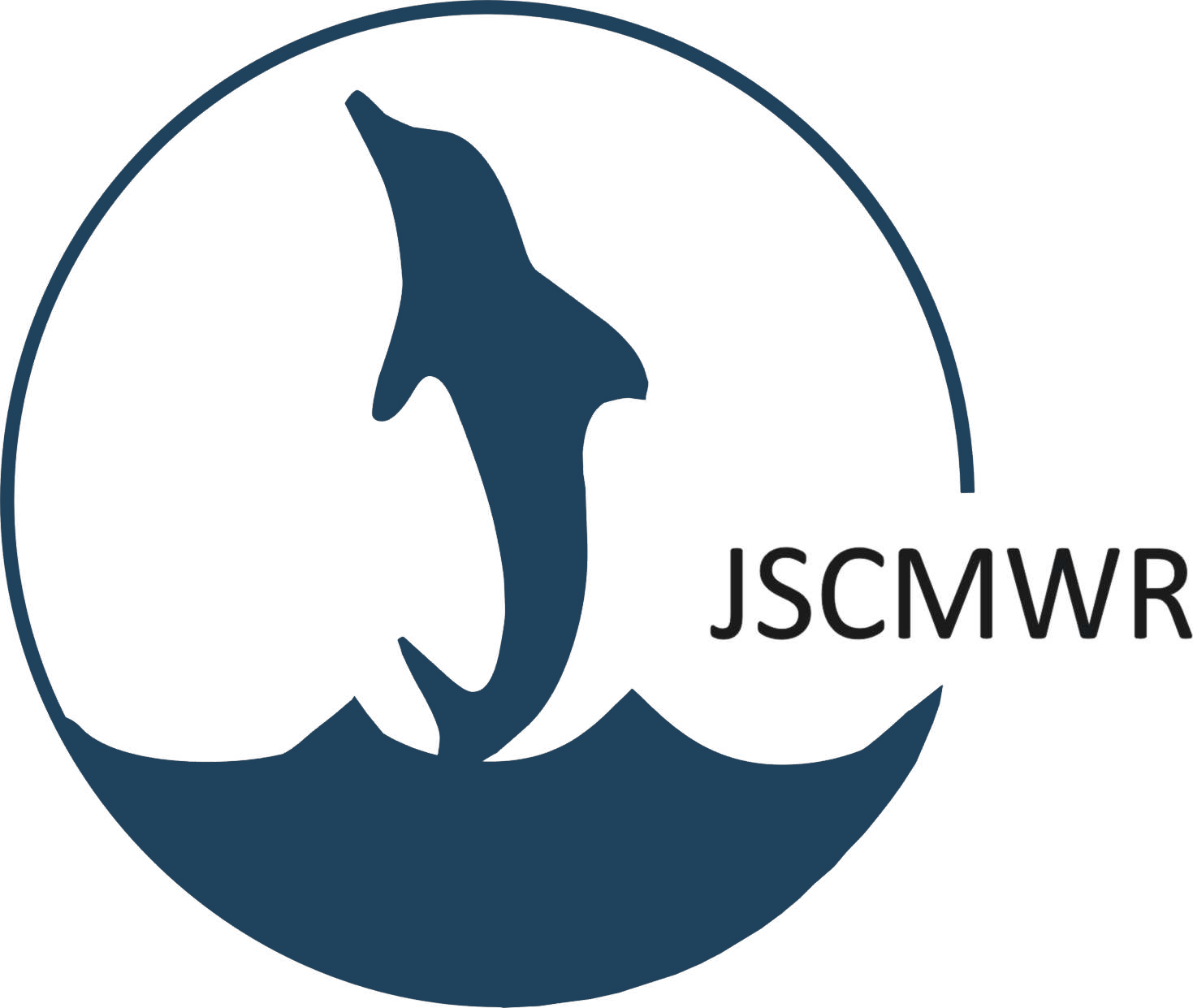
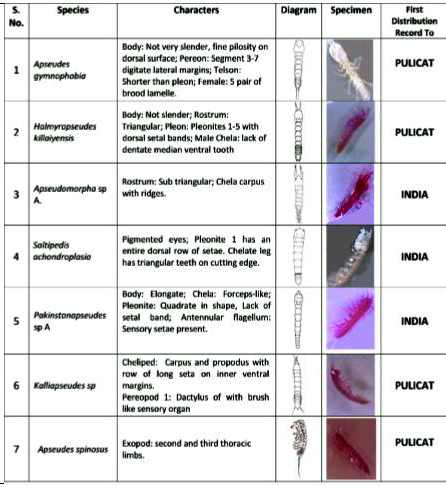
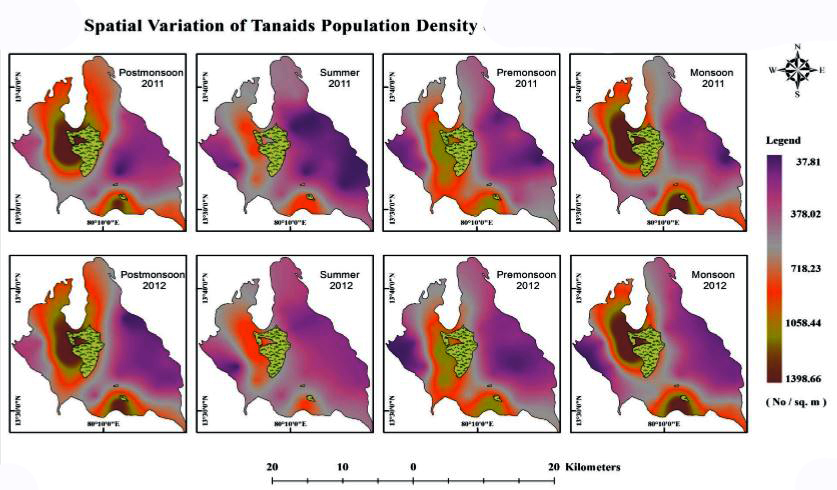 Apseudomorpha sp. A and Kalliapseudes sp were found in seven and five stations respectively. Stations such as St.1, St.6, St.7, St.17 and St.20 recorded with six species. St.2, St.10, St.11, St.16, St.18 and St.19 were recorded with five species. St.3, St.5, St.8, St.9, St.12, St.13 and St.14 were observed with four species and St.4 and St.15 noticed to have three species. Among the seven species, the most dominant one was Apseudes gymnophobia (31%) followed by Halmyrapseudes killaiyensis (28%), Apseudes chilkensis (24%), Saltipedis achondroplasia (10 %), Pakistanapseudes and Apseudomorpha (3 % each) and Kalliapseudes sp (1 %). The population density ranged from 38 no/sq. m to 399 no/ sq. m with mean population density of 623 no/ sq. m. The diversity of the tanaids population varied from 1.109 to 1.384. Evenness of the tanaids differentiated from 0.8 to 1. Species richness deviated from 0.54 to 0.96. Current study on tanaidacea perform key ecological role in the coastal lake ecosystem. The spatial and temporal distribution of tanaids are strongly influenced by physico-chemical parameters, seasons, substratum and its characters.
Apseudomorpha sp. A and Kalliapseudes sp were found in seven and five stations respectively. Stations such as St.1, St.6, St.7, St.17 and St.20 recorded with six species. St.2, St.10, St.11, St.16, St.18 and St.19 were recorded with five species. St.3, St.5, St.8, St.9, St.12, St.13 and St.14 were observed with four species and St.4 and St.15 noticed to have three species. Among the seven species, the most dominant one was Apseudes gymnophobia (31%) followed by Halmyrapseudes killaiyensis (28%), Apseudes chilkensis (24%), Saltipedis achondroplasia (10 %), Pakistanapseudes and Apseudomorpha (3 % each) and Kalliapseudes sp (1 %). The population density ranged from 38 no/sq. m to 399 no/ sq. m with mean population density of 623 no/ sq. m. The diversity of the tanaids population varied from 1.109 to 1.384. Evenness of the tanaids differentiated from 0.8 to 1. Species richness deviated from 0.54 to 0.96. Current study on tanaidacea perform key ecological role in the coastal lake ecosystem. The spatial and temporal distribution of tanaids are strongly influenced by physico-chemical parameters, seasons, substratum and its characters.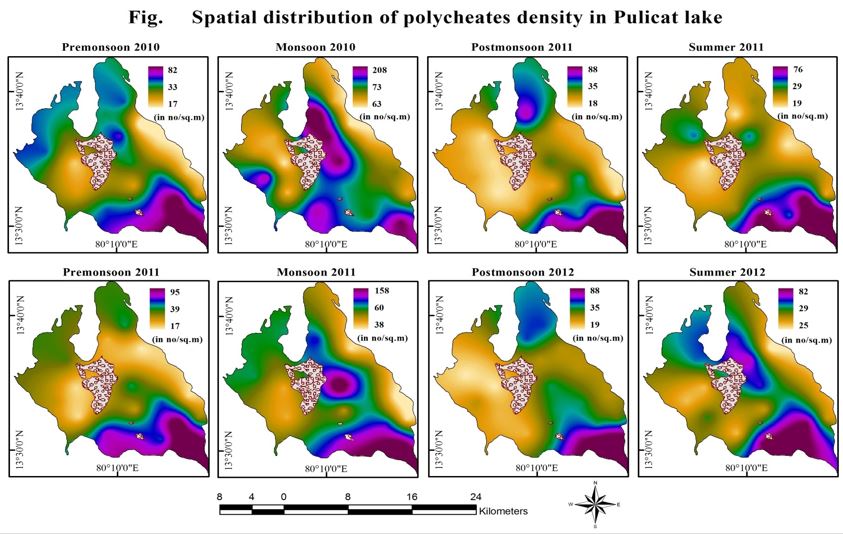 Among the ten species, the most dominant one was Armandia longicudata (43.38%) followed by Heteromastus filiformis(17.38%), Marphysa gravelyi (17.31%), Mediomastus capensis (5.84%), Namanereis quadraticeps(5.50%), Capitella capitata(4.55 %), Namalycastis siolii (4.14%), Mystides angolansis (1.09%), Microneredies capensis (0.48%) and Unanereis macgregori(0.34 %). The population density ranged from 17 no/sq.m to 208 no/sq.m and with mean population density of 58 no/sq.m. The diversity of polychaetes population varied from 1.96 to 2.456. Evenness of polychaetes differentiated from 0.79 to 0.99. Species richness deviated from 1.54 to 1.87. Hydrography, seaweeds and grasses cover, organic materials, nutrients, are the major factors influencing polychaetes density in Pulicat. Southern part of the lake had flourishing seaweeds and grasses and St.2 at Northern part of the lake found to be dominant of polychaetes where silt, organic carbon prevailed more during monsoon seasons.
Among the ten species, the most dominant one was Armandia longicudata (43.38%) followed by Heteromastus filiformis(17.38%), Marphysa gravelyi (17.31%), Mediomastus capensis (5.84%), Namanereis quadraticeps(5.50%), Capitella capitata(4.55 %), Namalycastis siolii (4.14%), Mystides angolansis (1.09%), Microneredies capensis (0.48%) and Unanereis macgregori(0.34 %). The population density ranged from 17 no/sq.m to 208 no/sq.m and with mean population density of 58 no/sq.m. The diversity of polychaetes population varied from 1.96 to 2.456. Evenness of polychaetes differentiated from 0.79 to 0.99. Species richness deviated from 1.54 to 1.87. Hydrography, seaweeds and grasses cover, organic materials, nutrients, are the major factors influencing polychaetes density in Pulicat. Southern part of the lake had flourishing seaweeds and grasses and St.2 at Northern part of the lake found to be dominant of polychaetes where silt, organic carbon prevailed more during monsoon seasons.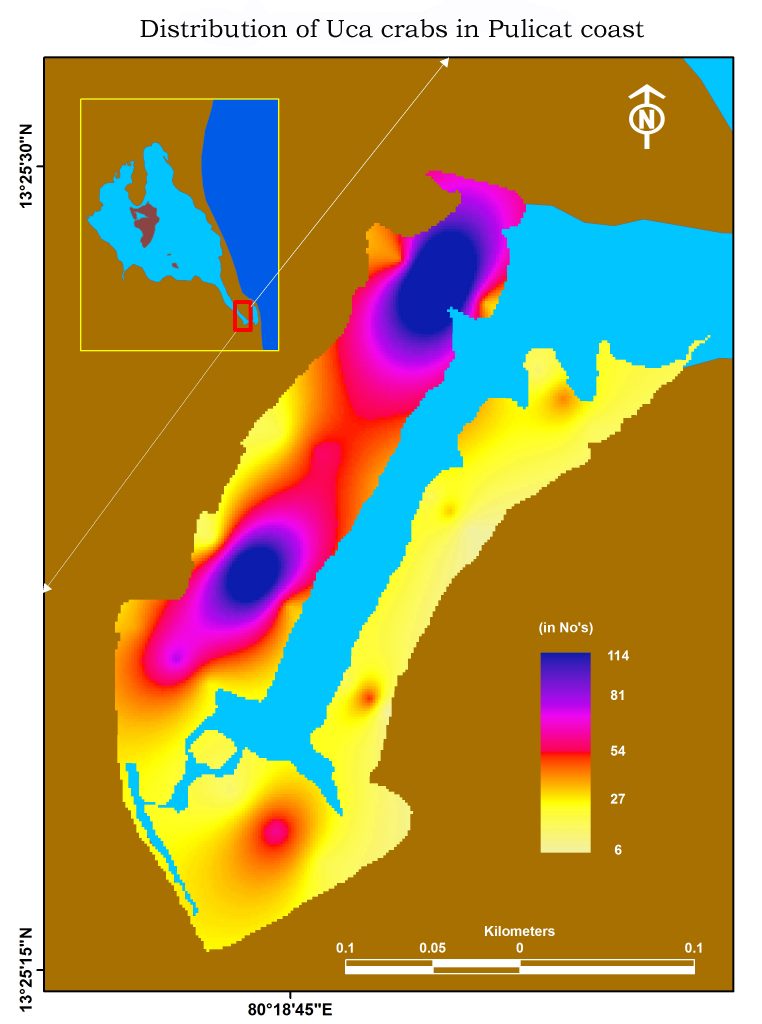 Twelve species of brackish water brachyuran were identified in major landing centers of Pulicat Lake They are Scylla serrata, Scylla tranqueberica, Matuta lunaris, Thalamita crenta, Chayribdis natator, Chayribdis feriatus, Portunas pelagicus, Portunas sanguinolentus, Uca annuplies, uca triangularis, Cardisoma carnifex, Diogenes avarus. There are two Uca species were identified in Pulicat. They are Uca annulipes and Uca triangularis. Density of fiddler crabs varied from 6 to 114 no /sq. meter. Measurement of burrow was observed with the presence of hoods, dimension, angle of decent of holes and burrow depth were noticed. Claw wavings were observed. There are 4 types of claw waving were noticed such as lateral circular waving, lateral flick waving, Rapid vertical waving, circular waving. Colour variation of the uca were noticed . The colour variation in the carapace of uca occurs according to the increase in temperature. Colour of the uca increases, when the temperature increases.Variation of temperature, Salinity and pH from 28.9 to 32.8 OC, 14 to 26 ppt and 6.6 to 7.5
Twelve species of brackish water brachyuran were identified in major landing centers of Pulicat Lake They are Scylla serrata, Scylla tranqueberica, Matuta lunaris, Thalamita crenta, Chayribdis natator, Chayribdis feriatus, Portunas pelagicus, Portunas sanguinolentus, Uca annuplies, uca triangularis, Cardisoma carnifex, Diogenes avarus. There are two Uca species were identified in Pulicat. They are Uca annulipes and Uca triangularis. Density of fiddler crabs varied from 6 to 114 no /sq. meter. Measurement of burrow was observed with the presence of hoods, dimension, angle of decent of holes and burrow depth were noticed. Claw wavings were observed. There are 4 types of claw waving were noticed such as lateral circular waving, lateral flick waving, Rapid vertical waving, circular waving. Colour variation of the uca were noticed . The colour variation in the carapace of uca occurs according to the increase in temperature. Colour of the uca increases, when the temperature increases.Variation of temperature, Salinity and pH from 28.9 to 32.8 OC, 14 to 26 ppt and 6.6 to 7.5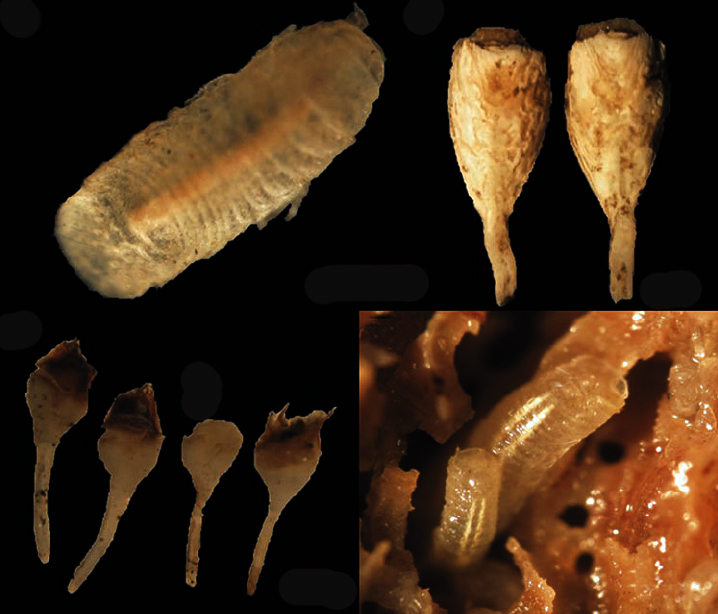 Four different types of fouling organisms were encountered in Pulicat Lake. They are Balanus amphirite, Balanus verticulatus, Cellana radiate and Crassostrae madarassensis. Balanus amphirite is the dominant species followed by balanus verticulatus, cellana radiate and oyster. Pillar has more prone to fouling by marine organisms than wood (boat). Maximum number of attachment by fouling organisms is 26 nos/ 5 sq. cms and the minimum is 4 nos/ 5 sq. cms. The weight of the fouling organisms between pillar and boat, boat and wood noticed to have higher weight of the fouling organisms.Though density of fouling organisms were high in pillar and concrete structures, weight of the organisms were low. Comparing length measurement of fouling organisms in both pillar and wood revealed that most of the fouling organisms are lesser length in pillar than boat. Experiment was carried out to check the fouling activity on temporal basis in Pulicat. Same sized wood and stone was selected. In the wood one was chosen for control and the other one painted with tar and later one painted with paints. Same setup was maintained in wood too. They were hanged in the water column for the period of 45 days. All materials have elevated weight due to primary line attachment. Control sample of wood have found with some minute fouling organisms mainly barnacles.There are three types of boring organisms were encountered in Pulicat lake. Glycera alba, Barnea birmanica and Bankia rochi. Boring organisms varied from 16 (wood 1, 3rd quadrate) to 24 (wood 4, 4rd quadrate) Nos / sq. meter (Fig 8). Wood borers were in high dense in wood 2 and low in wood no 5. Quadrate wise, borer density was higher in 4th quadrate and lesser in 2nd quadrate.
Four different types of fouling organisms were encountered in Pulicat Lake. They are Balanus amphirite, Balanus verticulatus, Cellana radiate and Crassostrae madarassensis. Balanus amphirite is the dominant species followed by balanus verticulatus, cellana radiate and oyster. Pillar has more prone to fouling by marine organisms than wood (boat). Maximum number of attachment by fouling organisms is 26 nos/ 5 sq. cms and the minimum is 4 nos/ 5 sq. cms. The weight of the fouling organisms between pillar and boat, boat and wood noticed to have higher weight of the fouling organisms.Though density of fouling organisms were high in pillar and concrete structures, weight of the organisms were low. Comparing length measurement of fouling organisms in both pillar and wood revealed that most of the fouling organisms are lesser length in pillar than boat. Experiment was carried out to check the fouling activity on temporal basis in Pulicat. Same sized wood and stone was selected. In the wood one was chosen for control and the other one painted with tar and later one painted with paints. Same setup was maintained in wood too. They were hanged in the water column for the period of 45 days. All materials have elevated weight due to primary line attachment. Control sample of wood have found with some minute fouling organisms mainly barnacles.There are three types of boring organisms were encountered in Pulicat lake. Glycera alba, Barnea birmanica and Bankia rochi. Boring organisms varied from 16 (wood 1, 3rd quadrate) to 24 (wood 4, 4rd quadrate) Nos / sq. meter (Fig 8). Wood borers were in high dense in wood 2 and low in wood no 5. Quadrate wise, borer density was higher in 4th quadrate and lesser in 2nd quadrate.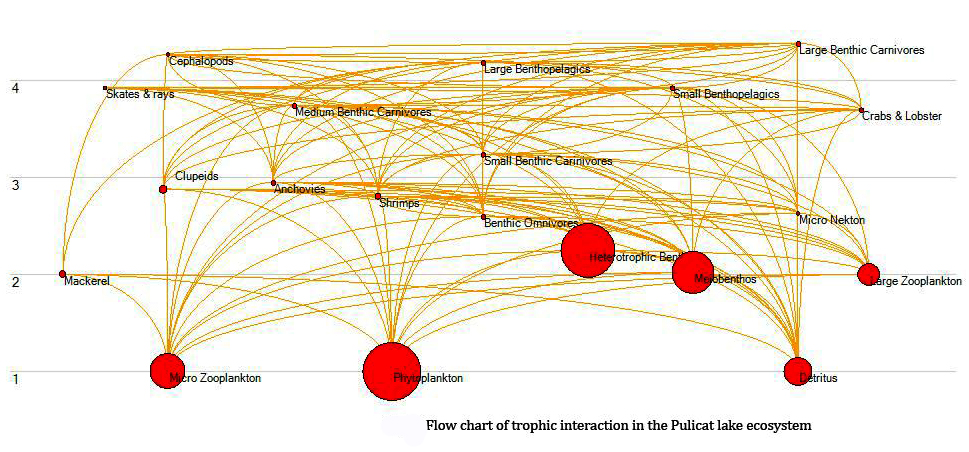 The prey and predator niche overlaps for pulicat lake indicates that tunas, cephalopods and large benthic carnivores have significant overlap in their diets with marine mammals. Maximum prey overlaps were observed for groups , medium benthic carnivores. Similarly, large pelegics and large benthopelagics had significant predator overlaps. Maximum predatory overlap was observed in the case of cephalopods. The selection indicates or electivity describe a predator’s preference for prey and in the pulicat lake pelegics, while it avoided small benthic carnivores and small benthopelagics. Group 5 medium benthic were very selective feeders (on benthic omnivores and large zooplankton) avoiding most prey groups. The search rates (volumes searched per unit time by a given predator j seeking a certain prey i) for groups of the pulicat lake indicated the higher trophic level groups had higher search rates than lower trophic level groups. Maximum primary production required for harvest of groups was observed for group 11 small benthopelagics, group 7 large benthopelagics and group 6 cephalopods. Maximum primary production required for consumption of groups was observed for lowertrophic level groups, viz., micro zooplankton, micro nekton, hertrophics benthos and anchovies. In the pulicat ecosystem higher trophic level groups had large ecological footprints (PPR per unit biomass) indicating that more resources were necessary to sustain their production. The mixed trophic impact analysis indicated that shore seines negatively impact mackerel and clupeids and gill net negatively impact on small benthopelagics . since anchovies are a food organisms for many groups, they have a positive impacts on cephalopods and small benthopelagics. The Pulicat lake ecosystem has relatively low ascendancy (43.5%) when compared to some other self systems. The systems is over head is approximately 56%. This suggest that the Pulicat lake ecosystem has significant strength in reserve and can either be resistant or resilient to perturbations with the capability to bounce back quickly to orginial levels . A trophic flow digram was constructed such that boxes representing organisms low in the food web are placed in the lower part of the graph, while the organisms high in the food web are put higher up. The boxes connected by means of trophic flows.The present ecological model constructed and the simulation made are a premilinary exercise and with the availability of better information and more vigorous data the model can be improved so as to reflect the reality in a better fashion. This study shows that ecological modelling is much better tool for management of multispecies fishery resources and should be applied to other major marine ecosystem in India
The prey and predator niche overlaps for pulicat lake indicates that tunas, cephalopods and large benthic carnivores have significant overlap in their diets with marine mammals. Maximum prey overlaps were observed for groups , medium benthic carnivores. Similarly, large pelegics and large benthopelagics had significant predator overlaps. Maximum predatory overlap was observed in the case of cephalopods. The selection indicates or electivity describe a predator’s preference for prey and in the pulicat lake pelegics, while it avoided small benthic carnivores and small benthopelagics. Group 5 medium benthic were very selective feeders (on benthic omnivores and large zooplankton) avoiding most prey groups. The search rates (volumes searched per unit time by a given predator j seeking a certain prey i) for groups of the pulicat lake indicated the higher trophic level groups had higher search rates than lower trophic level groups. Maximum primary production required for harvest of groups was observed for group 11 small benthopelagics, group 7 large benthopelagics and group 6 cephalopods. Maximum primary production required for consumption of groups was observed for lowertrophic level groups, viz., micro zooplankton, micro nekton, hertrophics benthos and anchovies. In the pulicat ecosystem higher trophic level groups had large ecological footprints (PPR per unit biomass) indicating that more resources were necessary to sustain their production. The mixed trophic impact analysis indicated that shore seines negatively impact mackerel and clupeids and gill net negatively impact on small benthopelagics . since anchovies are a food organisms for many groups, they have a positive impacts on cephalopods and small benthopelagics. The Pulicat lake ecosystem has relatively low ascendancy (43.5%) when compared to some other self systems. The systems is over head is approximately 56%. This suggest that the Pulicat lake ecosystem has significant strength in reserve and can either be resistant or resilient to perturbations with the capability to bounce back quickly to orginial levels . A trophic flow digram was constructed such that boxes representing organisms low in the food web are placed in the lower part of the graph, while the organisms high in the food web are put higher up. The boxes connected by means of trophic flows.The present ecological model constructed and the simulation made are a premilinary exercise and with the availability of better information and more vigorous data the model can be improved so as to reflect the reality in a better fashion. This study shows that ecological modelling is much better tool for management of multispecies fishery resources and should be applied to other major marine ecosystem in India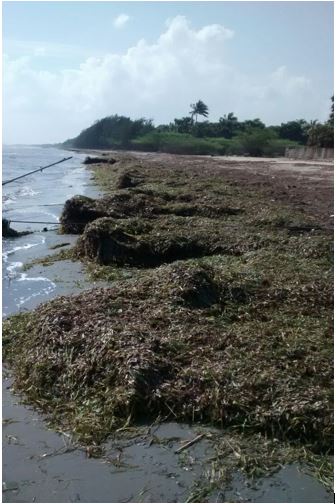 kg) was placed in the tray no 2 with 25 grams of halo tolerant earthworm (Pontodrilus litoralis) (Fig.4). 4th week, total wt of the earth worm increased in maximum (39 g) and started to decline and reached 1 g in 8th week.Interesting observation was Pontodrilus litoralis reached maximum weight and higher number in 28 days and superior to Cymodocea serrulata in terms of weight and number in short days. Syringodium isoetifolium (1 kg) was placed in the tray no 3 with 25 grams of halo tolerant earthworm (Pontodrilus litoralis). Beginning of experiment onwards earth worm Pontodrilus litoralis started to decline in numbers and weight. They were survived upto two weeks (14 days). Mixed (Syringodium isoetifolium, Halophila ovalis and Cymodocea serrulata) sea grass (1 kg) was placed in the fourth tray with 25 grams of halo tolerant earthworm. 3rd week, total wt of the earth worm increased in maximum (31g with 170 numbers) and after started to decline and reached 2 g and 10 numbers in 6th week. Some necessary components in the mixed seagrass might increase the reproduction rate of the worm, Pontodrilus litoralis drastically and simultaneously prevent the weight increase. 170 individuals has been developed through proliferation of Pontodrilus litoralis is the highest record in whole study. Coastal sand was placed in the tray (No 5) with 25 grams of halo tolerant earthworm (Pontodrilus litoralis). They were survived in seven days and found to dead at the end of 7th day. This tray is to know the longevity and life of earthworm without providing the food. Pontodrilus litoralis might survive seven days without food supply. Vermicompost was derived after 60 days. Cymodocea serrulata yielded 500 grams, Halophila ovalis yielded 300 grams and mixed sea grasses yielded 622 grams. However mixed seagrasses yielded high amount, it is properly turned into composit. All essential nutrients were enhanced and pollutants and heavy metals were reduced during the process of verimcomposit. Vermicompost suppress of specific insect attacks by various forms of organic amendments
kg) was placed in the tray no 2 with 25 grams of halo tolerant earthworm (Pontodrilus litoralis) (Fig.4). 4th week, total wt of the earth worm increased in maximum (39 g) and started to decline and reached 1 g in 8th week.Interesting observation was Pontodrilus litoralis reached maximum weight and higher number in 28 days and superior to Cymodocea serrulata in terms of weight and number in short days. Syringodium isoetifolium (1 kg) was placed in the tray no 3 with 25 grams of halo tolerant earthworm (Pontodrilus litoralis). Beginning of experiment onwards earth worm Pontodrilus litoralis started to decline in numbers and weight. They were survived upto two weeks (14 days). Mixed (Syringodium isoetifolium, Halophila ovalis and Cymodocea serrulata) sea grass (1 kg) was placed in the fourth tray with 25 grams of halo tolerant earthworm. 3rd week, total wt of the earth worm increased in maximum (31g with 170 numbers) and after started to decline and reached 2 g and 10 numbers in 6th week. Some necessary components in the mixed seagrass might increase the reproduction rate of the worm, Pontodrilus litoralis drastically and simultaneously prevent the weight increase. 170 individuals has been developed through proliferation of Pontodrilus litoralis is the highest record in whole study. Coastal sand was placed in the tray (No 5) with 25 grams of halo tolerant earthworm (Pontodrilus litoralis). They were survived in seven days and found to dead at the end of 7th day. This tray is to know the longevity and life of earthworm without providing the food. Pontodrilus litoralis might survive seven days without food supply. Vermicompost was derived after 60 days. Cymodocea serrulata yielded 500 grams, Halophila ovalis yielded 300 grams and mixed sea grasses yielded 622 grams. However mixed seagrasses yielded high amount, it is properly turned into composit. All essential nutrients were enhanced and pollutants and heavy metals were reduced during the process of verimcomposit. Vermicompost suppress of specific insect attacks by various forms of organic amendments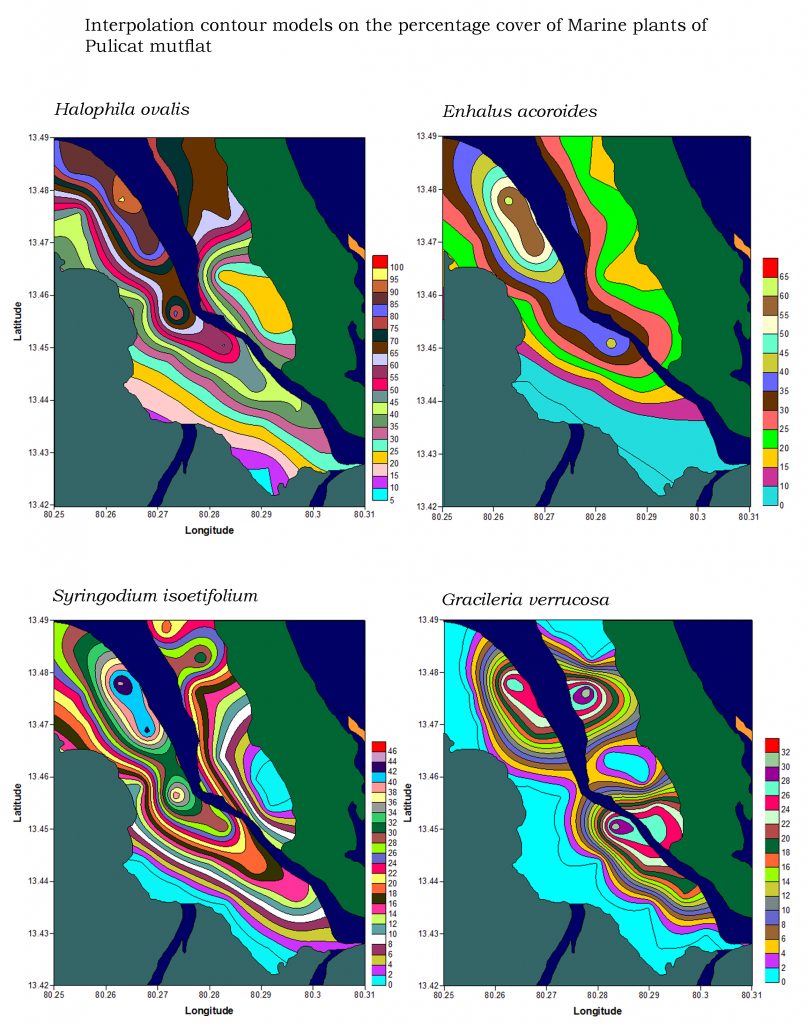 The following marine plants were observed and identified in Pulicat mudflat ecosystem. The seagrasses are Halophila ovalis (R.Br.) Hook, Syringodium isoetifolium (Asch) Dandy, Enhalus acoroides (L.F.) Royle, and seaweed Gracilaria verrucosa (Hudson). Occurrence study revealed that Halophila ovalis is the dominant species been observed in all stations. Enhalus acoroides has been observed in second dominant seagrass in the mudflat of Pulicat. Syringodium isoetifolium and Gracileria verrucosa were perceived 3rd and 4th dominant species. Study on growth and percentage cover revealed that Halophila ovalis has its unique character to occupy larger area in the study area. Enhalus acoroides is the second dominant species followed by Syringodium isoetifolium and Gracileria verrucosa. Enhalus acoroides yielded greaterbiomass followed by Halophila ovalis, Gracileria verrucosaI and Syringodium isoetifolium. The study area is subjected to moderate fluctuations in temperature from 29.2 – 32.5 oC. Salinity fluctuated from 21 to 36ppt. All marine plants except Halophila ovalis (also meager) in southern side of the mudflat are absent due to fresh water discharge nearby inhabitants. pH ranged from 7.1 to 7.5 and DO fluctuated from 3.1 and 4 mg/l. Nutrient supply seldom acts as a limiting factor in the abundance of marine plants. High content of nitrite in St 4 (14.03mg/l) and low value in St 18 (0.42mg/l) were observed. High amount of nitrate was recorded as 10.3mg/l (St.20) and low as 4 mg/l (St.6&7). Phosphate varied from 0.019 (St. 14) to 0.933 (St.5) mg/l. Silicate varied from 0.53 (St. 15) mg/l to 6.95 (St.12) mg/l.Organic carbon and organic matter can be formed by break down of fragments of seaweeds and sea grasses. In the present study, St 18 has identified to contribute less carbon/ matter and St. 15 contributed high content to the environment.
The following marine plants were observed and identified in Pulicat mudflat ecosystem. The seagrasses are Halophila ovalis (R.Br.) Hook, Syringodium isoetifolium (Asch) Dandy, Enhalus acoroides (L.F.) Royle, and seaweed Gracilaria verrucosa (Hudson). Occurrence study revealed that Halophila ovalis is the dominant species been observed in all stations. Enhalus acoroides has been observed in second dominant seagrass in the mudflat of Pulicat. Syringodium isoetifolium and Gracileria verrucosa were perceived 3rd and 4th dominant species. Study on growth and percentage cover revealed that Halophila ovalis has its unique character to occupy larger area in the study area. Enhalus acoroides is the second dominant species followed by Syringodium isoetifolium and Gracileria verrucosa. Enhalus acoroides yielded greaterbiomass followed by Halophila ovalis, Gracileria verrucosaI and Syringodium isoetifolium. The study area is subjected to moderate fluctuations in temperature from 29.2 – 32.5 oC. Salinity fluctuated from 21 to 36ppt. All marine plants except Halophila ovalis (also meager) in southern side of the mudflat are absent due to fresh water discharge nearby inhabitants. pH ranged from 7.1 to 7.5 and DO fluctuated from 3.1 and 4 mg/l. Nutrient supply seldom acts as a limiting factor in the abundance of marine plants. High content of nitrite in St 4 (14.03mg/l) and low value in St 18 (0.42mg/l) were observed. High amount of nitrate was recorded as 10.3mg/l (St.20) and low as 4 mg/l (St.6&7). Phosphate varied from 0.019 (St. 14) to 0.933 (St.5) mg/l. Silicate varied from 0.53 (St. 15) mg/l to 6.95 (St.12) mg/l.Organic carbon and organic matter can be formed by break down of fragments of seaweeds and sea grasses. In the present study, St 18 has identified to contribute less carbon/ matter and St. 15 contributed high content to the environment. Study concluded that the distribution and feeding habit of flamingos could be controlled by tidal inundation, coastal plants (seaweeds and sea grasses), mudflat extension, benthic array and profile, temperature, salinity, pH and depth of water. GIS prediction map (Fig.11) was prepared based on the crucial factors for distribution to enhance the population in terms of restoration of habitat. As it is a potential study, Pulicat ecosystem need such studies to attract the migratory birds by extending the habitat with all preferred crucial factors in near future. Pl. contact us for further details.
Study concluded that the distribution and feeding habit of flamingos could be controlled by tidal inundation, coastal plants (seaweeds and sea grasses), mudflat extension, benthic array and profile, temperature, salinity, pH and depth of water. GIS prediction map (Fig.11) was prepared based on the crucial factors for distribution to enhance the population in terms of restoration of habitat. As it is a potential study, Pulicat ecosystem need such studies to attract the migratory birds by extending the habitat with all preferred crucial factors in near future. Pl. contact us for further details.